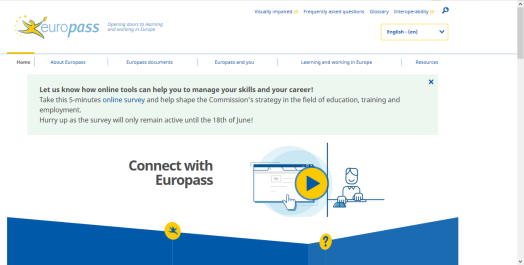Challenges Addressed
- Blended counselling
- Exchange and knowledge transfer (among educational professionals, guidance counsellors, etc.)
- Facilitation of transition from school education to career selection
- Improve matching between skills and jobs
- Improvement of guidance/ employment services
- Increase the interaction between schools and professional life
- Increase the mobility of people in Europe for education and employment purposes
- Promote self-assessment
- Provision of low-threshold information on educational guidance to disadvantaged adult populations
- Raise awareness on guidance
- Reduce early school leaving
- Support those wishing to re-enter the labour market
- Tackling unemployment
- Target unemployment
Europass consists of the following five elements:
- the Europass Curriculum Vitae (completed on individual level for qualifications, professional experience, skills and competences);
- the Europass Language Passport (completed on individual level for language skills);
- the Europass Certificate Supplement (issued by the authorities that award VET certificates, to add further information, make them more comprehensible to employers and institutions outside the issuing country);
- the Europass Diploma Supplement (issued by higher education institutions along with graduates’ degrees or diplomas, to make them more comprehensible outside the country awarded;
- the Europass Mobility Document (records all organised period of time that a person spends in another European country for the purpose of learning or training).
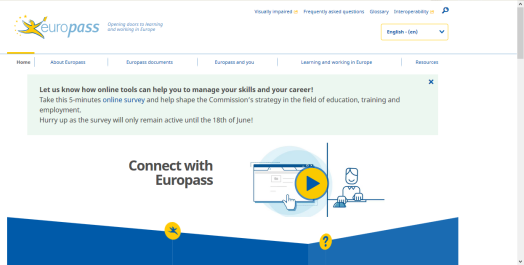
Policy objectives
- Access to Lifelong Guidance Services
- Assessing the effectiveness of Lifelong Guidance Provision
- Assuring the quality of Lifelong Guidance Provision
- Career Management Skills
- Contributing the rise of mobility of people in Europe for education and employment purposes
- Funding Lifelong Guidance Services
- ICT in Lifelong Guidance
- Improving careers information
- Improving employability and supporting older workers
- Interactive online tools
- Raising the skills and qualifications of adults
- Raising the skills and qualifications of young people
- Strategic Leadership
- Supporting people at risk and disadvantaged groups
- Training and Qualifications of Guidance Practitioners
INNOVATIVE ASPECTS OF LMI
- Blended counselling
- Creation of ePortfolios with students' skills and competences
- Crowed sourcing of expert knowledge on educational guidance
- Customisation of LMI through the users' adaptation according to their needs
- Data entered by end-users
- Effective job matching
- Guidance methods
- Informal LMI
- Innovative user profiling
- Interoperability with job-search engines
- Life course related filtering of LMI
- Matching of regional education to labour market
- News relevant to educational guidance
- Occupational information
- One-stop-shop
- Personalised educational advice
- Provision of additional information on the awards not available elsewhere, to make it easily understood to employers and institutions in other countries
- Provision of external links to available EC employment, guidance and educational services
- Real time LMI
- Scientific research on guidance
- Thematic compilation of third party LMI
- The “Working in Europe” section is more LMI updated as it provides external links to available EC employment, guidance and educational services;
- The Interoperability section liaises Europass with any organisation that maintains a CV database or manages personal data.
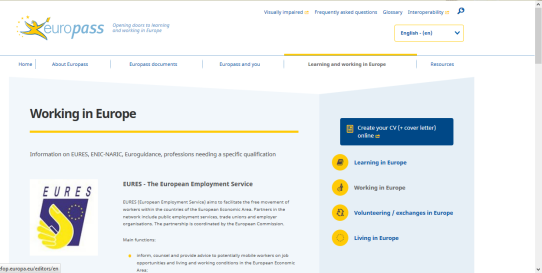
INNOVATIVE USE OF ICT
- Combination with offline elements
- Connection with third parties (LMI, PES, etc.)
- Customized RSS feed
- Dynamic interconnection of electronic resources according to a life course approach
- e-portfolio
- Interactive online tools
- Mobile app
- Online counselling
- Online wiki
- Open source
- Personalised information storage
- Quick diagnosis tool
- Social media utilisation
- The portal works with Open Source solid standards and is operable in HTML and XML;
- The interoperable aspects of Europass are defined in XML and JSON format;
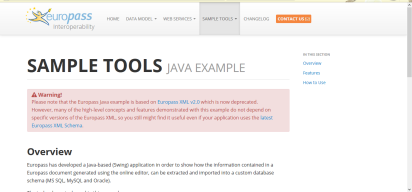
- An XML vocabulary implemented as an XML Schema to describe the information contained in the Curriculum Vitae (CV), Language Passport (LP) and European Skills Passport (ESP);
- Individuals who use the Europass online editors to create a CV, LP or ESP can save it in Europass XML format or PDF format with the XML attached. Both formats can be imported to the Europass online editors at a later stage for editing, or to any other system that understands the Europass XML.
Results and impacts obtained
- Quantitative: Total number of visits since launch in 2005 is estimated at almost 140 million. Overall, Europass users tend to be young, female and highly educated.
- Qualitative: the most important European added value was the creation of a set of international, recognised and uniform documents for recording qualifications, skills and experiences. An effective support system and a well-developed brand image led to international recognition of the documents, which was the key reason why they are chosen by the end-users.
- Evaluation process: every four years, the EC should submit to the Parliament and the Council an evaluation report on the implementation of Europass. Also, the portal collects statistical data on usage on monthly basis; and direct feedback – primarily on technical issues – is obtained via asynchronous communication means (e-mail).
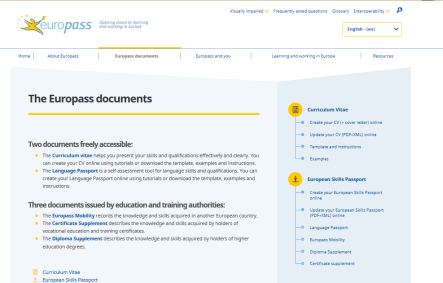
- Cooperation with similar European initiatives (e.g. Euroguidance);
- Pooling many resources in its dissemination;
- Joint efforts in keeping Europass up to date with the needs of various stakeholders through proper engagement strategies;
- Availability of Europass as a free tool;
- Direct involvement of NECs;
- Official requirement to use Europass documents across EU Member States.
- Lack of awareness of general public.
- Layout, content and design.
- Lack of a single document for describing and recording learning achievements and skills acquired in non-formal and informal settings.
- Keeping up to date with technological developments and making the platform more user-friendly.
Transferability elements
When Europass was initiated in 1991, mobility of students and employees around Europe was around 3%-4% due to reasons such as language barriers, lack of recognition of formal education and skills across Europe, absence of necessary legislation to facilitate mobility, etc. In 1998, the European Forum on Transparency of Vocational Qualifications concluded in the development of the Europass, as well as a network of National Reference Points for Vocational Qualifications (NRPs).
An annual amount of approximately EUR 2 million is being assigned to the initiative.
Cedefop is responsible for the overall operation and maintenance of Europass website: design and elaboration of the different templates uploaded on the website and the quality control of Europass’ different aspects.
Cedefop is supported technically by external IT organisations: e.g. in the development of additional, new modules; the provision of on-site services, etc.
Europass interoperability is based upon a common vocabulary that leverages the benefits of web services and public APIs.
Stakeholders' contribution to promotion and management of Europass documents.
The most important trend identified to be affecting the future course of Europass is interoperability. From an LMI perspective, Europass aims to explore the ways to further improve the job-matching aspects of the documents, to provide data mining and to accomplish skills intelligence.
